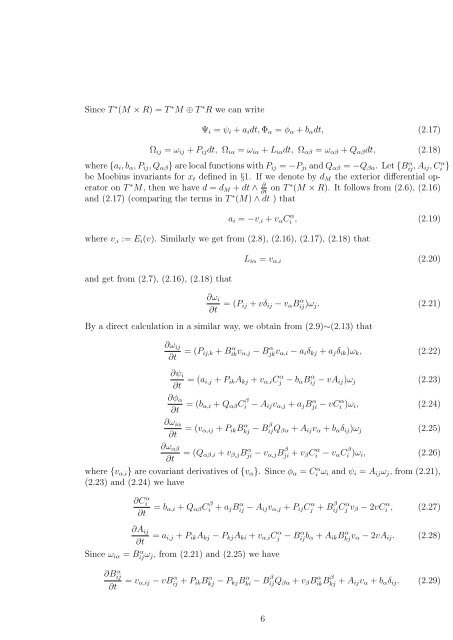The second variational formula for Willmore submanifolds
The second variational formula for Willmore submanifolds
The second variational formula for Willmore submanifolds
You also want an ePaper? Increase the reach of your titles
YUMPU automatically turns print PDFs into web optimized ePapers that Google loves.
Since T ∗ (M × R) = T ∗ M ⊕ T ∗ R we can write<br />
Ψi = ψi + aidt, Φα = φα + bαdt, (2.17)<br />
Ωij = ωij + Pijdt, Ωiα = ωiα + Liαdt, Ωαβ = ωαβ + Qαβdt, (2.18)<br />
where {ai, bα, Pij, Qαβ} are local functions with Pij = −Pji and Qαβ = −Qβα. Let {Bα ij, Aij, Cα i }<br />
be Moebius invariants <strong>for</strong> xt defined in §1. If we denote by dM the exterior differential operator<br />
on T ∗M, then we have d = dM + dt ∧ ∂<br />
∂t on T ∗ (M × R). It follows from (2.6), (2.16)<br />
and (2.17) (comparing the terms in T ∗ (M) ∧ dt ) that<br />
ai = −v,i + vαC α i , (2.19)<br />
where v,i := Ei(v). Similarly we get from (2.8), (2.16), (2.17), (2.18) that<br />
and get from (2.7), (2.16), (2.18) that<br />
Liα = vα,i<br />
(2.20)<br />
∂ωi<br />
∂t = (Pij + vδij − vαB α ij)ωj. (2.21)<br />
By a direct calculation in a similar way, we obtain from (2.9)∼(2.13) that<br />
∂ωij<br />
∂t = (Pij,k + B α ikvα,j − B α jkvα,i − aiδkj + ajδik)ωk, (2.22)<br />
∂ψi<br />
∂t = (ai,j + PikAkj + vα,iC α j − bαB α ij − vAij)ωj (2.23)<br />
∂φα<br />
∂t = (bα,i + QαβC β<br />
i − Aijvα,j + ajB α ji − vC α i )ωi, (2.24)<br />
∂ωiα<br />
∂t = (vα,ij + PikB α kj − B β<br />
ijQβα + Aijvα + bαδij)ωj<br />
(2.25)<br />
∂ωαβ<br />
∂t = (Qαβ,i + vβ,jB α ji − vα,jB β<br />
ji + vβC α i − vαC β<br />
i )ωi, (2.26)<br />
where {vα,i} are covariant derivatives of {vα}. Since φα = Cα i ωi and ψi = Aijωj, from (2.21),<br />
(2.23) and (2.24) we have<br />
∂C α i<br />
∂t = bα,i + QαβC β<br />
i + ajB α ij − Aijvα,j + PijC α j + B β<br />
ijC α j vβ − 2vC α i , (2.27)<br />
∂Aij<br />
∂t = ai,j + PikAkj − PkjAki + vα,iC α j − B α ijbα + AikB α kjvα − 2vAij. (2.28)<br />
Since ωiα = B α ijωj, from (2.21) and (2.25) we have<br />
∂B α ij<br />
∂t = vα,ij − vB α ij + PikB α kj − PkjB α ki − B β<br />
ijQβα + vβB α ikB β<br />
kj + Aijvα + bαδij. (2.29)<br />
6



